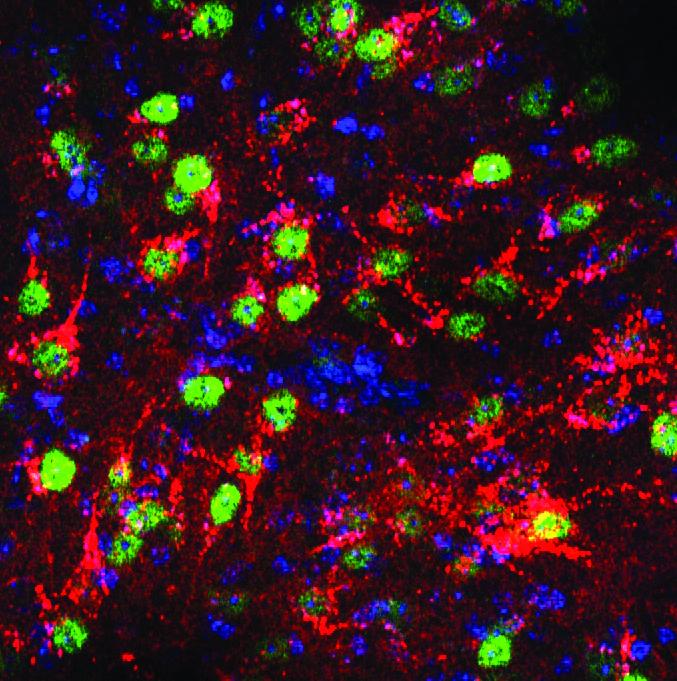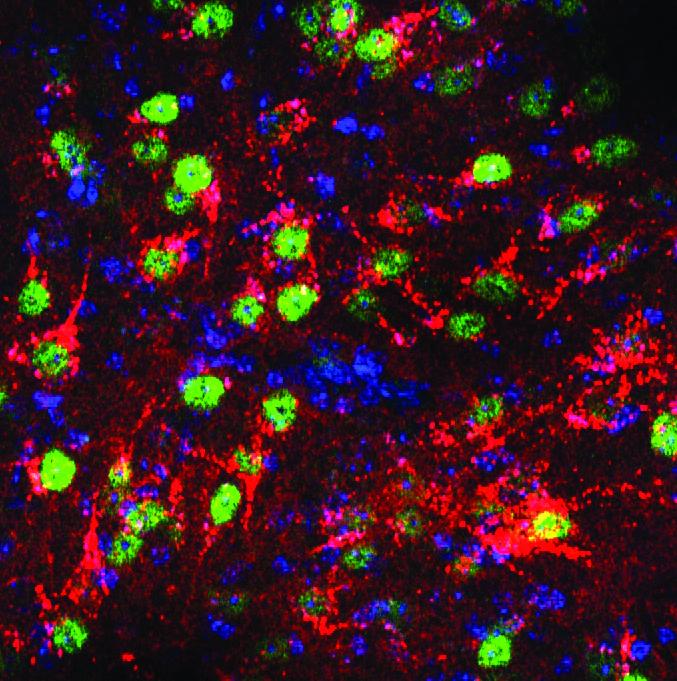
Credit: Dr. Andrew Huberman and Lindsey Salay, Stanford University
In a study of mice, National Institutes of Health-funded researchers describe a new circuit involved in fine-tuning the brain's decision either to hide or confront threats. The study, published in Nature, was partially funded by the NIH's Brain Research through Advancing Innovative Neurotechnologies (BRAIN) Initiative.
"Being able to manipulate specific circuits can uncover surprising relationships between brain areas and provide great insight into how the sensory, emotional, and behavioral centers work together to drive reactions," said Jim Gnadt, Ph.D., program director at the NIH's National Institute of Neurological Disorders and Stroke (NINDS) and a team lead for the BRAIN Initiative. "The tools and technologies developed through the BRAIN Initiative have made studies such as this one possible."
A team of researchers led by Andrew Huberman, Ph.D., professor of neurobiology and of ophthalmology at Stanford University in California, investigated the role of the ventral midline thalamus (vMT) in determining how animals respond to visual threats. The thalamus is a brain region that acts as a relay station, taking in sensory information, such as what is seen and heard, and sorting out where in the brain to send that information.
Dr. Huberman and his colleagues showed that the vMT was activated when mice were confronted with a threat, specifically a black circle that grew larger on top of their cage, mimicking the experience of something looming over them. When faced with the looming threat, the mice spent most of the time freezing or hiding and very little time rattling their tails, which is typically an aggressive response.
To further investigate the role of vMT, Dr. Huberman's team used state-of-the-art tools, including designer drugs that allowed specific circuits to be turned on and off. Although inactivating the vMT had no effect on freezing and hiding, it eliminated the tail rattling response. Turning on the vMT increased the number of tail shaking responses and caused the mice to move around more and spend less time hiding or freezing.
Dr. Huberman's group also discovered that the vMT sends information primarily to two brain areas: the basolateral amygdala (BLA) and the medial prefrontal cortex (mPFC). These circuits turned out to be critical in determining how the mice reacted to a visual threat. Turning on the circuit that projected to the BLA caused more freezing responses, while activating the mPFC circuit increased tail shaking responses.
"Dr. Huberman's work is opening a new area of vision research with the looming threat model, helping us understand how circuitry in the brain works from sensation to behavior," said Thomas Greenwell, Ph.D., program director at the NIH's National Eye Institute, which co-funded the study.
Dr. Huberman and his team showed that activation of the vMT increased arousal, a state of heightened alertness. Mice preferred spending more time in a room where they received vMT activation, suggesting that turning on that brain circuit made them feel good. Although there may have been a difference in response to the visual threat, either tail shaking or freezing, the underlying positive feeling was the same for both types of reactions.
"This study may help explain why acts of courage, such as standing up for yourself or for a cause, or a physical challenge can feel empowering. Experiencing that good feeling can also make it more likely to respond to future threats in a similar way," said Dr. Huberman. "Although our study was done in mice, learning more about the vMT may provide some insight into conditions such as generalized anxiety disorder and post-traumatic stress disorder and we are now pursuing study of the human vMT for that reason."
Future research is needed to increase understanding of ways in which the vMT circuit affects behavior and how to develop treatments that can target specific parts of this system.
###
This study was supported by the NINDS (NS090562) and the National Eye Institute (EY022157).
For more information:
http://www.ninds.nih.gov
http://www.braininitiative.nih.gov
References:
Salay et al. A midline thalamic circuit determines reaction to visual threats. Nature. May 2, 2018. DOI #: 10.1038/s41586-018-0078-2
This news release describes a basic research finding. Basic research increases our understanding of human behavior and biology, which is foundational to advancing new and better ways to prevent, diagnose, and treat disease. Science is an unpredictable and incremental process — each research advance builds on past discoveries, often in unexpected ways. Most clinical advances would not be possible without the knowledge of fundamental basic research.
The NIH's Brain Research through Advancing Innovative Neurotechnologies® (BRAIN) Initiative is aimed at revolutionizing our understanding of the human brain. It is managed by 10 institutes whose missions and current research portfolios complement the goals of the BRAIN Initiative: NCCIH, NEI, NIA, NIAAA, NIBIB, NICHD, NIDA, NIDCD, NIMH, and NINDS.
The NINDS is the nation's leading funder of research on the brain and nervous system. The mission of NINDS is to seek fundamental knowledge about the brain and nervous system and to use that knowledge to reduce the burden of neurological disease.
NEI leads the federal government's research on the visual system and eye diseases. NEI supports basic and clinical science programs to develop sight-saving treatments and address special needs of people with vision loss. For more information, visit https://www.nei.nih.gov.
About the National Institutes of Health (NIH): NIH, the nation's medical research agency, includes 27 Institutes and Centers and is a component of the U.S. Department of Health and Human Services. NIH is the primary federal agency conducting and supporting basic, clinical, and translational medical research, and is investigating the causes, treatments, and cures for both common and rare diseases. For more information about NIH and its programs, visit http://www.nih.gov.
Media Contact
Barbara McMakin
[email protected]
@NINDSnews
http://www.ninds.nih.gov





